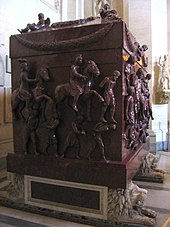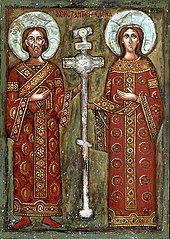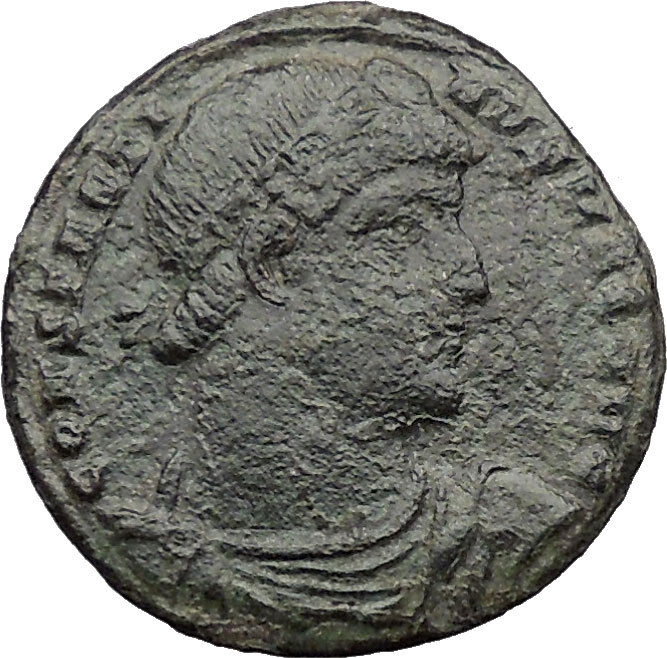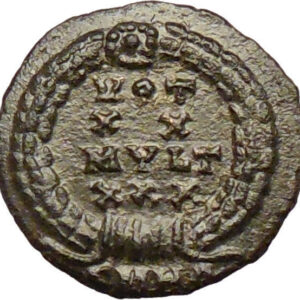|
Saint
Helena –
Roman Empress 324-328/330 A.D.
Bronze AE3 (BI Nummus)
18mm (1.79 grams) Nicomedia mint, struck circa 325-325 A.D.
Reference: RIC VII 129; Sear 16620
FL HELENA AVGVSTA, diademed bust
right, wearing mantle and necklace.
SECVRITAS REIPVBLICE / MNΓ,
Securitas standing left, lowering branch with right hand, raising hem of
robe with left hand.
You are bidding on the exact item pictured, provided with a Certificate
of Authenticity and Lifetime Guarantee of Authenticity.
Securitas – Security, as a goddess worshipped by the Romans, is
delineated in a great variety of ways on their imperial coins. She
appears for the most part under the form of a woman in matronly costume;
though in some few instances she is but half clothed, having a veil
thrown over the lower extremities. Sometimes she is quietly seated, as
if perfectly at her ease and having nothing to fear. That is to say, her
right or her left elbow rests on her chair, and the hand supports her
head, as in Nero. Or else one of her arms is placed above the head; an
attitude which ancient artists regarded as characteristic of repose. She
holds in one or other of her hands either a sceptre, or a scipio, or the
hasta pura, or a cornucopia, or a patera, or a globe. On some medals
there is near her a lighted altar; on others she stands leaning against,
or with her arm upon, a column or cippus, having sometimes the legs
crossed in a tranquil, easy posture, carrying one of the above-mentioned
symbols, or otherwise holding before her a branch or a crown of olive,
or a palm branch. The meaning of these various attitudes and attributes
is on the whole too evident to require explanation. There are medals of
nearly all the emperors (with flagrant inappropriateness to most of the
reigns) from Otho and Vitellius to Constans and Constantius jun., which
have for the type of their reverses this figure of Security, and present
for their legend the word SECVRITAS, with the addition of the words,
AVGVSTI, or AVGVSTORVM (security of the emperor or of the emperors);
ORBIS (security of the world) ; PVBLICA (public security) ; PERPETVA
(perpetual security) ; POPVLI ROMANI (security of the Roman people)
TEMPORVM (of the Times) ; IMPERII (of the empire) SAECVLI (of the age) ;
REPVBLICAE (of the republic), etc.
Helena – Augusta, 324-328/330 A.D.
| First
Wife of
Constantius I | Mother of
Constantine the the Great | Step-mother of Constantia and
Licinius I | Grandmother of
Crispus,
Constantine II,
Constantius II,
Constans, Constantina (wife of
Hanniballianus &
Constantius Gallus) and Helena the Younger | Great Grandmother of
Constantia (wife of
Gratian) |
 Helena, Helena,
Saint Helena, or St. Helen (Greek: Αγία Ελένη, Latin:
Flavia Iulia Helena Augusta; c. 250 – c. 330), was a Greek native
from the Greek city of Drepana (Δρέπανα) in the province of Bithynia in
Asia Minor. She became the consort of the future Roman Emperor
Constantius Chlorus (reigned 293-306) and the mother of the future
Emperor Constantine the Great (reigned 306-337). She ranks as an
important figure in the history of Christianity and of the world due to
her major influence on her son. Tradition credits her with a pilgrimage
to Syria Palaestina, particularly to Jerusalem, during which she
allegedly discovered the True Cross. Pious beliefs also associate her to
the foundation of the Vatican Gardens.
The Eastern Orthodox
Church, Oriental Orthodox Church, Roman Catholic Church, and the
Anglican Communion revere her as a saint; the Lutheran Church
commemorates her.
Family life

Saint Helena with the Cross, Lucas Cranach the Elder
.jpg/170px-Helena_of_Constantinople_(Cima_da_Conegliano).jpg)
Helena of Constantinople by Cima da Conegliano
Helena’s birthplace
is not known with certainty. The 6th-century historian Procopius is the
earliest authority for the statement that Helena was a native of
Drepanum, in the province of Bithynia in Asia Minor. Her son Constantine
renamed the city “Helenopolis” after her death around 330, which
supports the belief that the city was her birthplace. The Byzantinist
Cyril Mango has argued that Helenopolis was refounded to strengthen the
communication network around his new capital in Constantinople, and was
renamed simply to honor Helena, not to mark her birthplace. There was
also a Helenopolis in Palestine and a Helenopolis in Lydia. These
cities, and the province of Helenopontus in the Diocese of Pontus, were
probably both named after Constantine’s mother.
The bishop and
historian Eusebius of Caesarea states that she was about 80 on her
return from Palestine. Since that journey has been dated to 326-28,
Helena was probably born in 248 or 250. Little is known of her early
life. Fourth-century sources, following Eutropius’ “Breviarium,”
record that she came from a low background. Saint Ambrose was the first
to call her a stabularia, a term translated as “stable-maid” or
“inn-keeper”. He makes this fact a virtue, calling Helena a bona
stabularia, a “good stable-maid”. Other sources, especially those
written after Constantine’s proclamation as emperor, gloss over or
ignore her background.
It is unknown where she first met
Constantius. The historian Timothy Barness has suggested that
Constantius, while serving under Emperor Aurelian, could have met her
while stationed in Asia Minor for the campaign against Zenobia. It is
said that upon meeting they were wearing identical silver bracelets;
Constantius saw her as his soulmate sent by God. Barnes calls attention
to an epitaph at Nicomedia of one of Aurelian’s protectors, which could
indicate the emperor’s presence in the Bithynian region soon after 270.
The precise legal nature of the relationship between Helena and
Constantius is also unknown. The sources are equivocal on the point,
sometimes calling Helena Constantius’ “wife”, and sometimes, following
the dismissive propaganda of Constantine’s rival Maxentius, calling her
his “concubine”. Jerome, perhaps confused by the vague terminology of
his own sources, manages to do both.

Helena’s sarcophagus in the Museo Pio-Clementino, Vatican Museum, Rome
Some scholars, such as the historian Jan Drijvers, assert that
Constantius and Helena were joined in a common-law marriage, a
cohabitation recognized in fact but not in law. Others, like Timothy
Barnes, assert that Constantius and Helena were joined in an official
marriage, on the grounds that the sources claiming an official marriage
are more reliable.
Helena gave birth to the future emperor
Constantine I on 27 February of an uncertain year soon after 270
(probably around 272). At the time, she was in Naissus (Niš, Serbia). In
order to obtain a wife more consonant with his rising status,
Constantius divorced Helena some time before 289, when he married
Theodora, Maximian’s daughter under his command. (The narrative sources
date the marriage to 293, but the Latin panegyric of 289 refers to the
couple as already married). Helena and her son were dispatched to the
court of Diocletian at Nicomedia, where Constantine grew to be a member
of the inner circle. Helena never remarried and lived for a time in
obscurity, though close to her only son, who had a deep regard and
affection for her.

The shrine to Saint Helena in St. Peter’s Basilica
Constantine was
proclaimed Augustus of the Roman Empire in 306 by Constantius’ troops
after the latter had died, and following his elevation his mother was
brought back to the public life in 312, returning to the imperial court.
She appears in the Eagle Cameo portraying Constantine’s family, probably
commemorating the birth of Constantine’s son Constantine II in the
summer of 316. She received the title of Augusta in 325 and died
around 330, with her son at her side. She was buried in the Mausoleum of
Helena, outside Rome on the Via Labicana. Her sarcophagus is on display
in the Pio-Clementine Vatican Museum, although the connection is often
questioned. Next to her is the sarcophagus of her granddaughter Saint
Constantina (Saint Constance). Her skull is displayed in the Cathedral
of Trier, in Germany.
Sainthood

Orthodox Bulgarian icon of Constantine and St. Helena
Helena is
considered by the Eastern Orthodox, Oriental Orthodox, Eastern and Latin
Catholic churches, as well as by the Anglican Communion and Lutheran
Churches, as a saint, famed for her piety. She is sometimes known as
Helen of Constantinople to distinguish her from others with similar
names.
Her feast day as a saint of the Orthodox Christian Church
is celebrated with her son on 21 May, the “Feast of the Holy Great
Sovereigns Constantine and Helen, Equal to the Apostles.” Likewise,
Anglican churches, and some Lutheran churches, keep the Eastern date.
Her feast day in the Roman Catholic Church falls on 18 August. Her feast
day in the Coptic Orthodox Church is on 9 Pashons.
Eusebius
records the details of her pilgrimage to Palestine and other eastern
provinces (though not her discovery of the True Cross). She is the
patron saint of new discoveries.
Her discovery of the Cross along
with Constantine is dramatised in the Santacruzan, a ritual
pageant in the Philippines. Held in May (when Roodmas was once
celebrated), the procession also bears elements of the month’s Marian
devotions.
Letter From Constantine to Macarius of Jerusalem
“Such is our Saviour’s grace, that no power of language seems adequate
to describe the wondrous circumstance to which I am about to refer. For,
that the monument (the cross) of his (Christ) most holy Passion,
so long ago buried beneath the ground, should have remained
unknown for so long a series of years, until its reappearance to his
servants now set free through the removal of him who was the common
enemy of all, is a fact which truly surpasses all admiration. I have no
greater care than how I may best adorn with a splendid structure that
sacred spot, which, under Divine direction, I have disencumbered as it
were of the heavy weight of foul idol worship;(Roman temple of Venus) a
spot which has been accounted holy from the beginning in God’s judgment,
but which now appears holier still, since it has brought to light a
clear assurance of our Saviour’s passion. “
“There was a temple of
Venus on the spot. This the queen (Helena) had destroyed.”
Relic
discoveries
See also: Early centers of Christianity § Jerusalem

Titular statue of Santa Liena, Birkirkara Malta, during the village
festa procession, 21 August 2011
Constantine appointed his mother
Helena as Augusta Imperatrix, and gave her unlimited access to the
imperial treasury in order to locate the relics of Judeo-Christian
tradition. In 326-28 Helena undertook a trip to the Holy Places in
Palestine. According to Eusebius of Caesarea she was responsible for the
construction or beautification of two churches, the Church of the
Nativity, Bethlehem, and the Church of Eleona on the Mount of Olives,
sites of Christ’s birth and ascension, respectively. Local founding
legend attributes to Helena’s orders the construction of a church in
Egypt to identify the Burning Bush of Sinai. The chapel at Saint
Catherine’s Monastery-often referred to as the Chapel of Saint Helen-is
dated to the year AD 330.
Jerusalem was still being rebuilt
following the destruction caused by Titus in AD 70. Emperor Hadrian had
built during the 130s a temple over the site of Jesus’s tomb near
Calvary, and renamed the city Aelia Capitolina. Accounts differ
concerning whether the temple was dedicated to Venus or Jupiter
According to tradition, Helena ordered the temple torn down and,
according to the legend that arose at the end of the 4th century, chose
a site to begin excavating, which led to the recovery of three different
crosses. The legend is recounted in Ambrose, On the Death of
Theodosius (died 395) and at length in Rufinus’ chapters appended to
his translation into Latin of Eusebius’ Ecclesiastical History,
the main body of which does not mention the event. Then, Rufinus
relates, the empress refused to be swayed by anything short of solid
proof and performed a test. Possibly through Bishop Macarius of
Jerusalem, she had a woman who was near death brought from the city.
When the woman touched the first and second crosses, her condition did
not change, but when she touched the third and final cross she suddenly
recovered, and Helena declared the cross with which the woman had been
touched to be the True Cross. On the site of discovery, Constantine
ordered the building of the Church of the Holy Sepulchre; churches were
also built on other sites detected by Helena. Sozomen and Theodoret
claim that Helena also found the nails of the crucifixion. To use their
miraculous power to aid her son, Helena allegedly had one placed in
Constantine’s helmet, and another in the bridle of his horse.

Helena’s head relic in the crypt of Trier cathedral
Helena left
Jerusalem and the eastern provinces in 327 to return to Rome, bringing
with her large parts of the True Cross and other relics, which were then
stored in her palace’s private chapel, where they can be still seen
today. Her palace was later converted into the Basilica of the Holy
Cross in Jerusalem. This has been maintained by Cistercian monks in the
monastery which has been attached to the church for centuries.
Tradition says that the site of the Vatican Gardens was spread with
earth brought from Golgotha by Helena to symbolically unite the blood of
Christ with that shed by thousands of early Christians, who died in the
persecutions of Nero.
According to one tradition, Helena acquired
the Holy Tunic on her trip to Jerusalem and sent it to Trier.
According to Byzantine tradition, Helena is responsible for the large
population of cats in Cyprus. Local tradition holds that she imported
hundreds of cats from Egypt or Palestine in the fourth century AD to rid
a monastery of snakes. The monastery is today known as “St. Nicholas of
the Cats” (Greek Άγιος Νικόλαος των Γατών) and is located near Limassol.
Several relics purportedly discovered by Saint Helena are now in Cyprus,
where she spent some time. Among them are items believed to be part of
Jesus Christ’s tunic, pieces of the holy cross, and pieces of the rope
with which Jesus was tied on the Cross. The rope, considered to be the
only relic of its kind, has been held at the Stavrovouni Monastery,
which was also founded by Saint Helena.
Depictions in British
folklore

Helena finding the True Cross, Italian manuscript c. 825
In Great
Britain, later legend, mentioned by Henry of Huntingdon but made popular
by Geoffrey of Monmouth, claimed that Helena was a daughter of the King
of Britain, Cole of Colchester, who allied with Constantius to avoid
more war between the Britons and Rome. Geoffrey further states that she
was brought up in the manner of a queen, as she had no brothers to
inherit the throne of Britain. The source for this may have been
Sozomen’s Historia Ecclesiastica, which however does not claim
Helena was British but only that her son Constantine picked up his
Christianity there. Constantine was with his father when he died in
York, but neither had spent much time in Britain.
The statement
made by English chroniclers of the Middle Ages, according to which
Helena was supposed to have been the daughter of a British prince, is
entirely without historical foundation. It may arise from the
similarly-named Welsh princess Saint Elen (alleged to have married
Magnus Maximus and to have borne a son named Constantine) or from the
misinterpretation of a term used in the fourth chapter of the panegyric
on Constantine’s marriage with Fausta. The description of Constantine
honoring Britain oriendo (lit. “from the outset”, “from the
beginning”) may have been taken as an allusion to his birth (“from
his beginning”) although it was actually discussing the beginning of
his reign.
At least twenty-five holy wells currently exist in the
United Kingdom dedicated to a Saint Helen. She is also the patron saint
of Abingdon and Colchester. St Helen’s Chapel in Colchester was believed
to have been founded by Helena herself, and since the 15th century, the
town’s coat of arms has shown a representation of the True Cross and
three crowned nails in her honour. Colchester Town Halll has a Victorian
statue of the saint on top of its 50-metre-high (160 ft) tower. The arms
of Nottingham are almost identical because of the city’s connection with
Cole, her supposed father.
Depictions in fiction
In
medieval legend and chivalric romance, Helena appears as a persecuted
heroine, in the vein of such women as Emaré and Constance;
separated from her husband, she lives a quiet life, supporting herself
on her embroidery, until such time as her son’s charm and grace wins her
husband’s attention and so the revelation of their identities.
Helena is the protagonist of Evelyn Waugh’s novel Helena. She is
also the main character of Priestess of Avalon (2000), a fantasy
novel by Marion Zimmer Bradley and Diana L. Paxson. She is given the
name Eilan and depicted as a trained priestess of Avalon.
Helena
is also the protagonist of Louis de Wohl’s novel The Living Wood,
1947, in which she is again the daughter of King Coel of Colchester.
|





 Helena,
Helena, 
.jpg/170px-Helena_of_Constantinople_(Cima_da_Conegliano).jpg)










